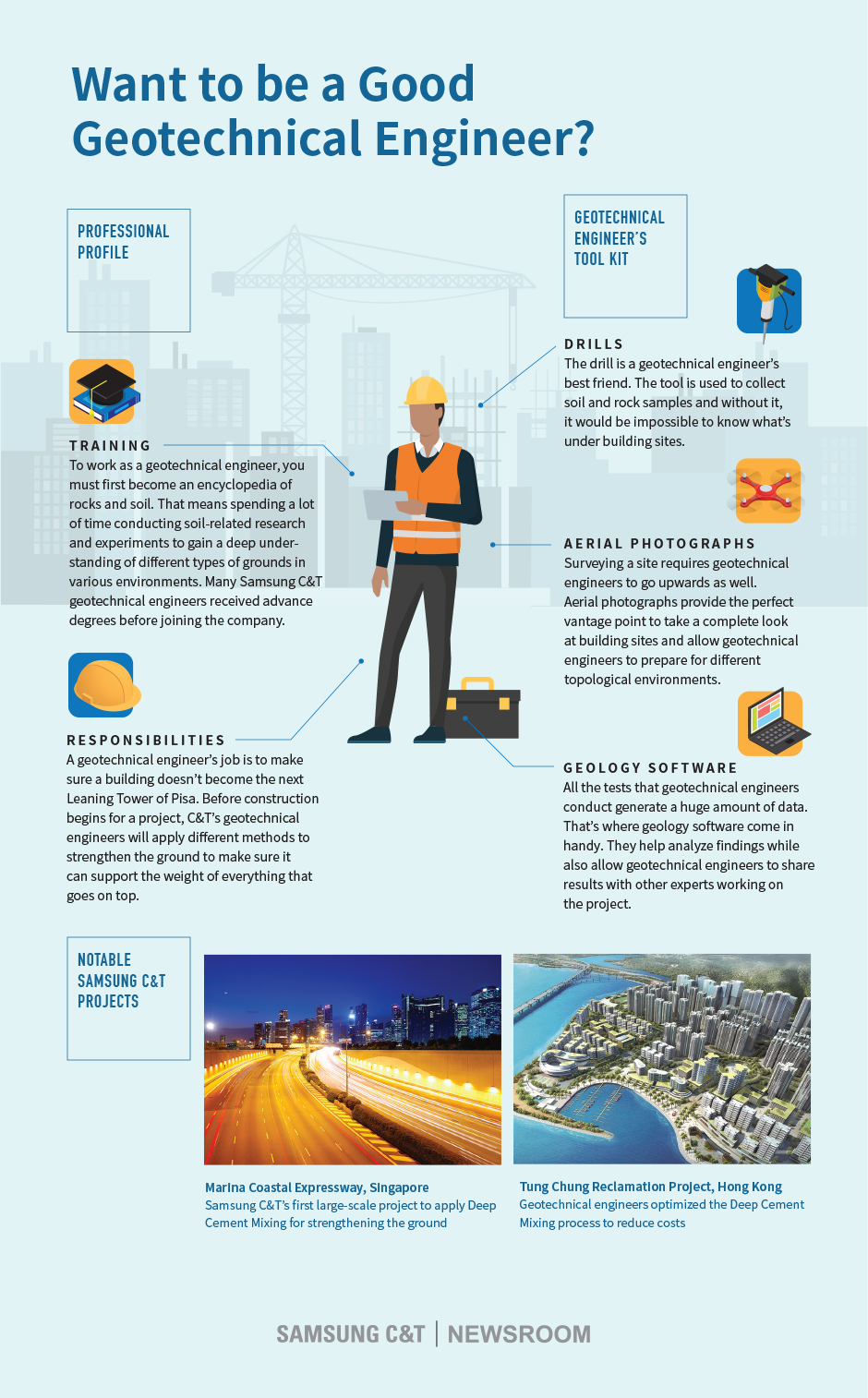The Only Guide to Geotheta
Table of ContentsA Biased View of GeothetaGeotheta for DummiesSome Ideas on Geotheta You Should KnowSome Known Factual Statements About Geotheta The Main Principles Of Geotheta

They perform site investigations, collect examples, carry out lab examinations, and examine data to examine the viability of the ground for building and construction jobs - Tailings Engineer. Based upon their searchings for, geotechnical engineers offer recommendations for structure design, incline stability, retaining frameworks, and mitigation of geotechnical hazards. They work together with other experts, such as architects, structural engineers, and building and construction teams, to make certain that geotechnical factors to consider are integrated into the overall task layout and execution
By assessing the actions and buildings of dirt and rock, they can determine potential geotechnical threats such as landslides, dirt settlement, or incline instability. Their expertise helps prevent failings or crashes that could threaten lives and building. Below are some thorough responsibilities and obligations of a geotechnical engineer: Website Examination: Geotechnical engineers conduct site investigations to collect data on subsurface problems.
They analyze the information to recognize the homes and behavior of the dirt and rock, including their toughness, leaks in the structure, compaction features, and groundwater conditions. Geotechnical Analysis and Style: Geotechnical engineers analyze the data gathered during website investigations to evaluate the security and viability of the website for building tasks. They perform geotechnical calculations and modeling to assess variables such as bearing ability, negotiation, slope security, lateral planet pressures, and groundwater flow.
Geotheta Can Be Fun For Anyone
Foundation Design: Geotechnical engineers play an essential duty in creating structures that can safely sustain the desired framework. They evaluate the dirt problems and load requirements to determine the proper foundation type, such as superficial foundations (e.g., footings), deep structures (e.g (https://slides.com/geotheta)., heaps), or specialized methods like soil renovation. They consider elements such as settlement limitations, bearing capability, and soil-structure interaction to establish optimal structure designs
They review building plans, display site tasks, and carry out area assessments to confirm that the design suggestions are complied with. If unexpected geotechnical issues develop, they assess the situation and provide referrals for remediation or modifications to the layout. Danger Assessment and Mitigation: Geotechnical engineers evaluate geotechnical risks and threats connected with the job site, such as landslides, liquefaction, or dirt disintegration.

Cooperation and Communication: Geotechnical designers work very closely with various other professionals associated with a project, such as designers, architectural designers, and building and construction teams. Effective communication and partnership are necessary to incorporate geotechnical factors to consider into the overall task layout and building process. Geotechnical engineers provide technological know-how, solution questions, and make sure that geotechnical demands are satisfied.
The Best Strategy To Use For Geotheta
Here are some sorts of geotechnical engineers: Foundation Designer: Foundation engineers specialize in designing and analyzing structures for structures. They evaluate the soil problems, tons demands, and site characteristics to identify the most appropriate foundation kind and design, such as superficial structures, deep structures, or specialized techniques like stack structures.
They review the elements influencing incline security, such as soil buildings, groundwater problems, and slope geometry, and establish approaches to prevent slope failures and minimize dangers. Earthquake Designer: Earthquake designers specialize in examining and creating structures to hold up against seismic forces. They assess the seismic threat of a site, review soil liquefaction potential, and create seismic layout criteria to guarantee the safety and security and strength of structures throughout earthquakes.
They carry out field screening, accumulate examples, and examine the accumulated data to characterize the dirt residential or commercial properties, geologic formations, and groundwater problems at a site. Geotechnical Instrumentation Designer: Geotechnical instrumentation engineers concentrate on tracking and gauging the behavior of soil, rock, and structures. They set up and keep instrumentation systems that keep an eye on aspects such as soil negotiation, groundwater levels, slope movements, and structural variations to examine efficiency and give early cautions of potential see this page problems.
Facts About Geotheta Uncovered
They conduct tests such as triaxial examinations, consolidation examinations, direct shear examinations, and leaks in the structure examinations to gather data for geotechnical analysis and style. Geosynthetics Engineer: Geosynthetics engineers concentrate on the layout and application of geosynthetic materials, such as geotextiles, geogrids, and geomembranes. They make use of these products to improve dirt stability, reinforce inclines, offer water drainage options, and control disintegration.
They tend to be investigative people, which means they're intellectual, reflective, and curious. They are curious, methodical, reasonable, logical, and logical. Some of them are additionally social, implying they're kind, generous, cooperative, individual, caring, helpful, compassionate, tactful, and friendly - Consulting Engineer.
In the office setting, geotechnical designers use specialized software application tools to execute calculations, create layouts, and evaluate data. They prepare records, review project requirements, communicate with customers and employee, and coordinate project activities. The office setup provides a favorable setting for research study, analysis, and partnership with various other professionals associated with the project.
5 Simple Techniques For Geotheta
They often check out job sites to carry out site investigations, examine geotechnical conditions, and gather information for analysis. These sees involve traveling to various locations, occasionally in remote or difficult terrains. Geotechnical designers might do soil sampling, conduct examinations, and display building and construction activities to ensure that the geotechnical elements of the job are being executed appropriately.
Geotechnical engineers likewise function in specialized geotechnical labs. Geotechnical research laboratory designers function extensively in these settings, handling testing devices, operating instruments, and taping data.